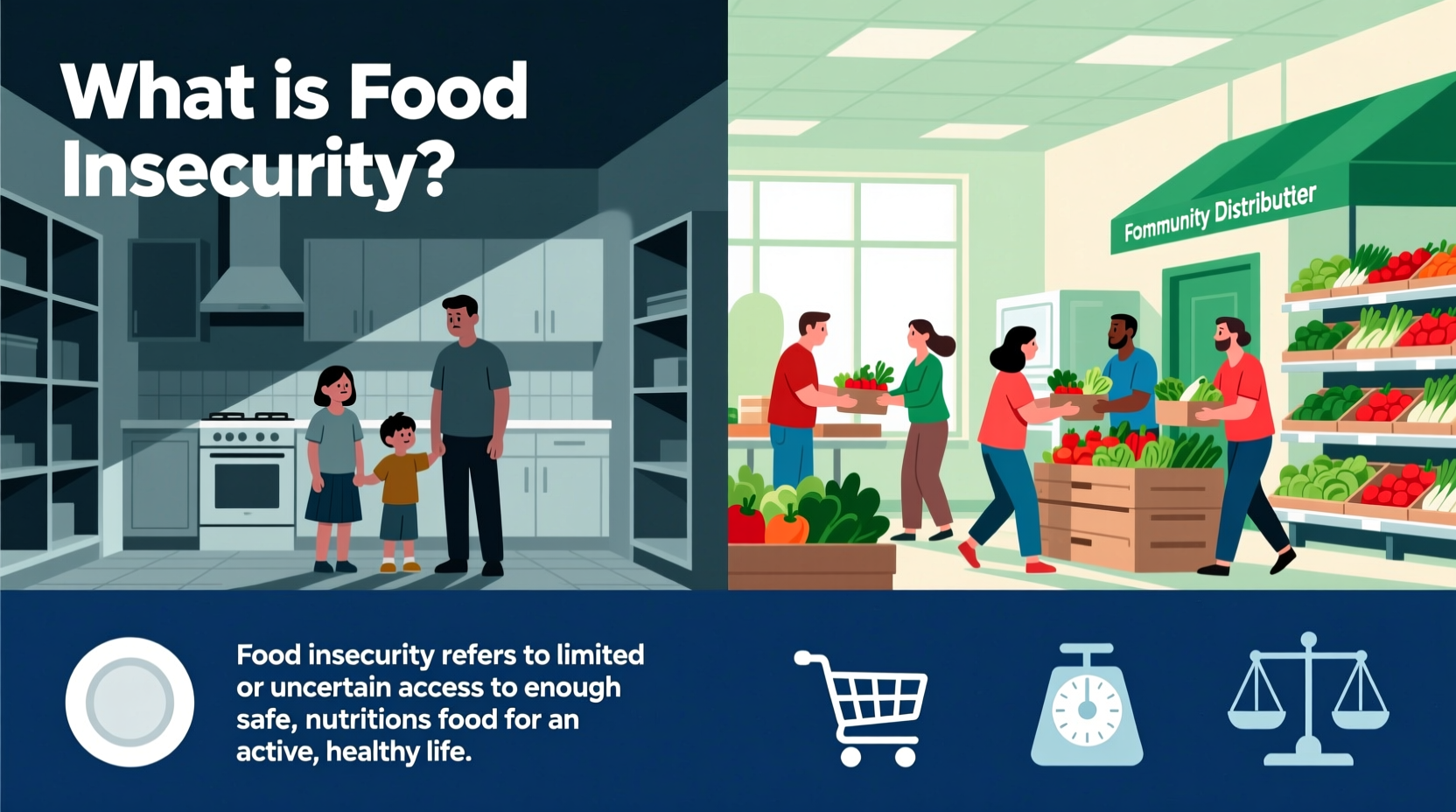Understanding what food insecurity means can help you recognize it in your community, support those affected, and advocate for meaningful solutions. This comprehensive guide breaks down the concept with authoritative data, clarifies common misconceptions, and provides practical insights into one of society's most pressing challenges.
Breaking Down Food Insecurity: More Than Just Hunger
Food insecurity represents a specific condition where households experience reduced quality, variety, or desirability of diet due to limited resources. Unlike temporary hunger—which is a physical sensation—food insecurity describes a socioeconomic situation where consistent access to nutritious food is compromised.
The U.S. Department of Agriculture (USDA) uses an 18-item survey to measure food insecurity through indicators like:
- Worrying whether food would run out before money available to buy more
- Reducing meal sizes or skipping meals due to financial constraints
- Unable to afford balanced meals
| Concept | Definition | Key Characteristics |
|---|---|---|
| Food Insecurity | Limited/uncertain access to adequate food due to financial constraints | Economic condition, measured at household level, can be temporary or chronic |
| Hunger | Physical sensation of discomfort from insufficient food intake | Individual experience, physiological response, short-term condition |
| Poverty | Insufficient income to meet basic needs | Broad economic condition, includes but extends beyond food access |
How Food Insecurity Is Officially Measured
The evolution of food insecurity measurement reflects growing understanding of this complex issue:
1995: USDA develops first standardized food security survey module
2006: Introduction of the 18-item Household Food Security Survey Module
2012: Global adoption of comparable metrics through FAO's Food Insecurity Experience Scale
2020: Pandemic-related adjustments to measurement protocols for remote data collection
Today, food insecurity is categorized into four levels:
- Food Secure: No reported indications of food access problems
- Marginal Food Security: Occasional anxiety about food sufficiency without reduced intake
- Low Food Security: Reduced quality and variety of diet, but generally sufficient quantity
- Very Low Food Security: Multiple indications of disrupted eating patterns and reduced food intake
Who Experiences Food Insecurity: Current Statistics
According to the latest USDA Economic Research Service data from 2022, 12.8% of U.S. households (17.0 million) experienced food insecurity at some point during the year. Certain populations face disproportionately higher rates:
- Households with children: 15.3% (vs. 9.6% for households without children)
- Black households: 22.0% (vs. national average of 12.8%)
- Hispanic households: 17.2%
- Households below poverty line: 39.5%
Globally, the United Nations Food and Agriculture Organization (FAO) reports that approximately 735 million people faced chronic hunger in 2022, with the highest prevalence in Sub-Saharan Africa (20.2%) and Southern Asia (15.7%).

Understanding the Root Causes
Food insecurity rarely stems from a single factor. Key contributing elements include:
- Economic instability: Low wages, unemployment, and high cost of living
- Systemic barriers: Transportation limitations, food deserts, and discriminatory policies
- Health challenges: Medical expenses and diet-related health conditions
- Social determinants: Education level, housing instability, and childcare costs
It's crucial to recognize that food insecurity manifests differently across contexts. In urban settings, transportation barriers and food deserts often play significant roles, while rural communities may face different challenges like limited grocery store availability and agricultural dependency. Understanding these context boundaries helps develop more effective solutions.
The Real-World Impact of Food Insecurity
Food insecurity creates ripple effects that extend far beyond meal skipping:
- Health consequences: Higher rates of diabetes, heart disease, and obesity due to reliance on cheaper, less nutritious options
- Child development: Impaired cognitive development and academic performance in children
- Economic burden: Estimated $160 billion annual healthcare costs associated with food insecurity in the U.S.
- Mental health: Increased anxiety, depression, and stress related to food uncertainty
Research published in the American Journal of Public Health shows that households experiencing food insecurity visit emergency rooms 46% more frequently than food-secure households, demonstrating the profound health implications of this socioeconomic condition.
Recognizing Food Insecurity in Your Community
Food insecurity often hides behind everyday behaviors. Look for these less obvious signs:
- Choosing cheaper, less nutritious options despite cooking skills
- Using unconventional food sources like community gardens or food pantries while maintaining employment
- Experiencing "feast and famine" cycles where food availability fluctuates monthly
- Expressing anxiety about food sufficiency despite not appearing visibly hungry
Remember that food insecurity exists across all demographics—even in households with employed adults. The USDA reports that 66% of food-insecure households with children had at least one working adult.
Where to Find Help and Support
If you or someone you know is experiencing food insecurity, these resources provide confidential assistance:
- SNAP (Supplemental Nutrition Assistance Program): The largest federal nutrition assistance program in the U.S. Apply through your state agency
- 211: Dial 211 or visit 211.org to connect with local food resources
- Feeding America: Network of food banks serving communities nationwide
- Local food pantries: Often connected to community centers, places of worship, or schools
Many colleges and workplaces now offer emergency food assistance programs—don't hesitate to inquire about available resources.
Building Food Security: Practical Steps
While systemic change is needed, individuals and communities can take meaningful action:
- Support local food policy councils working on systemic solutions
- Volunteer with or donate to community food programs
- Advocate for living wage policies and affordable housing initiatives
- Learn about and support culturally appropriate food access programs
Understanding what food insecurity means in practical terms empowers us to move beyond stereotypes and develop effective, compassionate responses to this complex challenge.
What's the difference between food insecurity and hunger?
Food insecurity is a socioeconomic condition of limited access to adequate food, while hunger is the physical sensation of discomfort from insufficient food intake. A household can be food insecure without members experiencing hunger if they've developed coping strategies like reducing meal quality while maintaining quantity.
Can someone be food insecure but not hungry?
Yes. Many food-insecure households experience marginal or low food security where they worry about food running out or reduce dietary quality, but still consume sufficient calories. This represents the majority of food-insecure households in the United States.
How does the government measure food insecurity?
The USDA uses an 18-item Household Food Security Survey Module that asks about experiences like worrying food would run out, reducing meal sizes, or skipping meals due to financial constraints. Responses determine whether a household is food secure or food insecure, and at what severity level.
Does food insecurity only affect low-income households?
While income is a major factor, food insecurity can affect households at various income levels. Medical emergencies, job loss, or unexpected expenses can create temporary food insecurity even in middle-income households. The USDA reports that 26% of food-insecure households had incomes above 185% of the poverty line.
How has food insecurity changed since the pandemic?
Food insecurity initially spiked during the pandemic but decreased in 2021-2022 due to expanded federal assistance programs. However, rates remain higher than pre-pandemic levels, particularly for households with children. The USDA reports 12.8% of U.S. households experienced food insecurity in 2022, compared to 10.5% in 2019.











 浙公网安备
33010002000092号
浙公网安备
33010002000092号 浙B2-20120091-4
浙B2-20120091-4